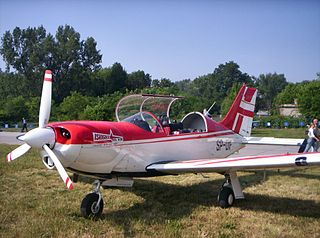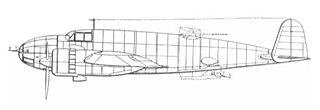
The PZL.23 Karaś was a Polish light bomber and reconnaissance aircraft designed in the mid-1930s by PZL in Warsaw.
The LWS-6 Żubr was a twin-engined medium bomber designed and produced by the Polish aircraft manufacturer LWS. It was only produced in limited numbers and was used for training purposes as it proved to be inferior to the contemporary PZL.37 Łoś medium bomber.

The PZL P.11 is a Polish fighter aircraft, designed and produced in the early 1930s by Państwowe Zakłady Lotnicze. Possessing an all-metal structure, metal-covering, and high-mounted gull wing, the type held the distinction of being widely considered the most advanced fighter aircraft in the world at the time of its introduction into service.

The PZL P.7 was a Polish gull wing monoplane fighter aircraft designed in the early 1930s at the PZL factory in Warsaw. It was the main fighter of the Polish Air Force between 1933 and 1935. The PZL P.7 was replaced in Polish service by its follow-up design, the PZL P.11c. More than 30 PZL P.7 fighters remained in service during the Invasion of Poland, scoring several kills despite its obsolescence.

The Lublin R-XIII was the Polish army cooperation plane, designed in the early-1930s in the Plage i Laśkiewicz factory in Lublin. It was the main army cooperation plane in the Invasion of Poland. Its variant Lublin R-XIV was a military trainer aircraft.

The RWD-14 Czapla was a Polish army cooperation aircraft, designed in the mid-1930s by the RWD team, and produced in the LWS factory from 1938. A series of 65 aircraft were built and most were used by the Polish Air Force observation squadrons during World War II in 1939.

Lubelska Wytwórnia Samolotów was a Polish aerospace manufacturer, located in Lublin, created in 1936 from Plage i Laśkiewicz works and produced aircraft between 1936 and 1939.

The LWS-2 was the Polish air ambulance aircraft prototype, designed in the late-1930s in the LWS factory.

PZL.46 Sum (sheatfish) was a light bomber developed by Państwowe Zakłady Lotnicze shortly before World War II, which, was directed to serial production in the spring of 1939. These planes were in production, but the Polish industry did not manage to produce them before the outbreak of the war.

PZL.50 Jastrząb (Hawk) was a Polish late 1930s fighter aircraft designed by Wsiewołod Jakimiuk at Państwowe Zakłady Lotnicze. The single-seat low-wing monoplane was to serve as a multi-purpose fighter and escort to replace all other fighters in the Polish Military Aviation. Designed after 1936, its prototype first flew in February 1939. By September, the first production aircraft were nearing completion, but further development was interrupted by the Nazi-Soviet Invasion of Poland.

The PZL-101 Gawron (rook) is a Polish agricultural and utility aircraft designed and built by WSK-Okęcie.

The PZL.38 Wilk (wolf) (PZL-38) was a Polish heavy fighter developed and manufactured by PZL state factory in 1937. Intended for use primarily as a fighter-bomber, the Polish Air Force also envisioned it replacing light fighters in long-range operations, along with being able to serve as a light bomber. Only two examples were built before the project was cancelled in favor of a planned improved variant, the PZL.48 Lampart.

PZL M26 Iskierka or M26 Airwolf is a Polish trainer and aerobatic aircraft, designed at WSK PZL-Mielec.
The LWS-7 Mewa II ("Seagull") was a Polish observation and close reconnaissance aircraft, designed in the 1939 by the LWS factory as a development of the earlier LWS-3 Mewa. Aircraft development was ordered by the Polish Air Force, but no prototypes were built.

The PZL-106 Kruk is a Polish agricultural aircraft designed and built by WSK PZL Warszawa-Okęcie.
The Lublin R-XX was the Polish torpedo bomber floatplane, designed in the early 1930s in the Plage i Laśkiewicz factory in Lublin. It remained a prototype.

The PZL.43 was a Polish light bomber and reconnaissance aircraft designed in the mid-1930s by PZL in Warsaw. It was an export development of the PZL.23 Karaś. Its main user was the Bulgarian Airforce who called it the Chaika.
The PZL.48 Lampart (leopard) was a Polish heavy fighter-bomber design, that remained only a project, owing to the outbreak of World War II.

The PZL.4 was a Polish three-engine passenger aircraft for 10 passengers, built in PZL factory in 1932, which remained a prototype. It was the first Polish-designed and produced multi-engine plane.

The PZL.49 Miś was a Polish twin-engined medium bomber design that remained only a project due to the outbreak of World War II. The PZL.49 was based on the contemporary PZL.37 Łoś and was to replace it at production lines at Państwowe Zakłady Lotnicze.

















